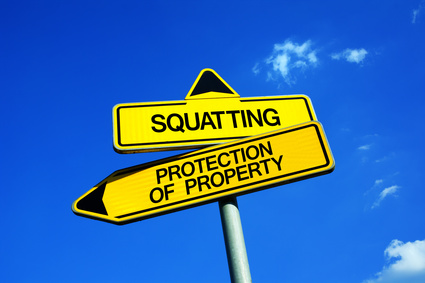Squatters? How to Remove them Legally.
Published on March 3, 2018 by Sarah Mac

A squatter is someone who has no right to be in your property. In other words, they are trespassing.
Squatters usually gain access to a property during vacant periods, but sometimes another tenant will let them in. It may be your tenant has had a long term guest during the rental period who decides they are not going to leave once the tenant has vacated at the end of the tenancy.
A tenant that has an agreement with you, or who used to have one, is not classed as a squatter.
Squatting used to be something of a minefield subject, with the law seemingly weighted in favour of the squatter. However, not so long ago, it became a criminal offence to trespass upon residential property. This means that landlords with squatters can request that the police remove them.
All good in theory; however, the police have in many cases demonstrated a lack of eagerness to get involved in such matters, perhaps because they are unsure of the provisions of the new law. In some cases they may delay involvement until certain steps have been taken by the property owner.
So what to do if you are losing out on rental income because your property is occupied by squatters and how to follow the correct procedure so that the police are happy to work with you? Let’s walk through the stages involved in the legal removal of squatters so that you can ensure your actions are not going to lead you to committing your own criminal offence.
How to remove squatters from my property?
There are two methods you can use to remove squatters from your property:
- Interim Possession Order (IPO) – to evict the squatters only
- Claim for possession – to evict the squatters and make a claim for damages
The Government website recommends taking legal advice when making a claim for possession. This is because the process must be followed to the letter, otherwise the court quite simply won’t award your claim.
Whatever you do, be sure not to make any attempt to remove the squatters under your own steam by threat or force. This will be considered a crime. Instead, you have to follow one of the procedures outlined above.
Removing squatters with an Interim Possession Order
If less than 28 days have passed since you realised your property has been squatted, you can use an IPO.
You will need to fill out the IPO application form and send it to your local county court. Be sure to send it to the correct court. Within a few days they will send you confirmation along with documents that you will need to serve to the squatters within 48 hours.
Once the IPO has been served, the squatters are legally obliged to leave the property within 24 hours. They must also stay away from your property for 12 months. Failure to comply is likely to land them a custodial sentence.
If your property has been damaged by squatters and you wish to make a claim for those damages, then you will need to make a claim for possession.
Removing Squatters by making a Claim for Possession
If more than 28 days have passed since you knew about the squatters, and / or you also wish to make a claim for damage caused by the squatters, you will need to make a claim for possession. This process is the same one used in situations where tenants are in rental arrears and you wish to repossess your property.
You will need to make a claim under Section 8 of the Housing Act 1988, and in doing so will need to present grounds 2, 8, 10-15 and/or 17 as listed in Schedule 2 to the Act.
These grounds cover issues such as anti-social behaviour, rent arrears, broken obligations under the tenancy agreement, property deterioration caused by tenant negligence and ill-treatment of furniture provided under the tenancy. In the case of claiming for damages caused by squatters, you’ll usually be looking at ground 13, 14 or 15 which deal with the condition of the property.
You will need to give notice of your intention to regain possession. The notice period will vary depending on which grounds you are using and will be anything from two weeks to two months.
You will need to complete the special Form 3 to give notice. It is a good idea to consult a legal specialist to ensure the correct grounds are stated and the right notice period is given.
A court order will be issued which will stipulate a date by which the squatters will be required to vacate the property.
If the squatters refuse to vacate the property by the date given then it will be necessary to apply for a warrant of possession. This will involve the court sending a bailiff to evict the squatter.
Be on your guard
As you can see, the process for removing squatters is quite a complex one. It is best therefore to try to avoid such a scenario in the first place.
If your property is being left vacant for any period of time, be sure to invest in additional security measures. Make sure that your previous tenants have returned all the keys provided at check-in and use your mid-term inspections as an opportunity to investigate whether there are any long term guests residing at the property who could potentially become squatters once the tenancy is over. At check-out, ensure all personal possessions are removed and that there are no signs of anyone intending to stay behind.

